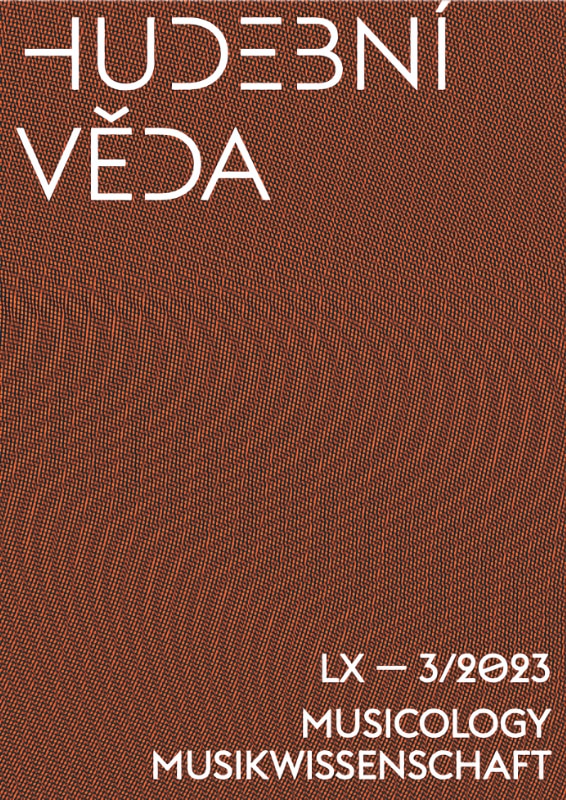Článek | Article
Autor:
Eva Ferková
Název:
Genetika a geometria v hudobnej teórii súčasnosti
Variantní název:
Genetics and Geometry in Present-time Music Theory
Zdrojový dokument:
Hudební věda LX (2023), č. 3, s. 301–322.
DOI:
https://doi.org/10.54759/MUSICOLOGY-2023-0302
Trvalý odkaz:
https://kramerius.lib.cas.cz/uuid/uuid:9516a248-4020-4393-8982-405bfdb33303
České resumé:
Způsob, jak vysvětlit vznik a vývoj hudby a její význam pro člověka, lze popsat mimo jiné také pomocí nástrojů a metod genetiky či metod matematiky a geometrie.
1. Memetika hudby je odvozena z teorie přirozeného výběru a genetické dědičnosti, kterou poprvé vysvětlil Charles Darwin a na konci 20. století dále rozpracoval Richard Dawkins. Hlavní principy této teorie aplikované v hudbě uvádí základní kniha Stevena Jana. Je založena na myšlence, že nejmenší jednotky/tvary kulturního nebo uměleckého artefaktu jsou podobné genům a lze je nazvat „memy“. Memetické struktury hudebních skladeb závisí na třech hlavních vlastnostech „memu“ – plodnost, dlouhověkost, věrnost kopírování. Každý mem existuje, pokud se může replikovat. Důkaz jeho existence je založen na četném výskytu strukturálních prvků, které lze nalézt ve více skladbách různých skladatelů v různých stylových obdobích. Steven Jan poukázal na některé, zejména melodické memy. Naše hypotéza poukazuje na pravděpodobnost memetické podstaty v neméně důležitém hudebním parametru, kde by se memetická struktura mohla masivně replikovat – v harmonii.
2. Geometrie hudby je základem teoretické koncepce anglického hudebního teoretika Dmitrije Tymoczka. Vizualizace hudební struktury není ve své podstatě zcela nová, v hudební teorii se k vizualizaci hudebních vztahů v minulosti používaly některé geometrické objekty – jako kvintový kruh, mřížka vztahů kvintakordů, kruh diatonických tercií a funkcí a pod. Topologická vizualizace vztahů tonálních prostor na trojrozměrném útvaru toroidu je zpracována ve studii Hendrica Purwinse a dalších. Předkládaný článek se snaží vysvětlit možnosti, jak využít geometrických metod a principů při vizuální prezentaci některých hudebních vztahů a struktur, jako jsou intervaly, akordy, tonální vztahy a pod. Následně jsou prezentovány nové informace, které lze získat pomocí takových geometrických pohledů.
English summary:
The way to explain the origin and development of music and its meaning for humans can be described using tools and methods of genetics or methods of mathematics and geometry.
1. The memetics of music is derived from the theory of natural selection and genetic inheritance, first developed by Charles Darwin, and at the end of the 20th century revised by Richard Dawkins. The main principles of this theory applied in music are presented in the standard book on the subject authored by Steven Jan. It is based on the premise that the smallest units/shapes of a cultural or artistic artifact are similar to genes and can be designated “memes”. Memetic structures of musical compositions depend on three main features of “meme”: namely, fecundity, longevity, and copy-fidelity. A meme exists as long as it can replicate. Proof of its existence is based on the occurrence of structural elements that can be found in multiple compositions produced by different composers in different style periods. Steven Jan pointed out several melodic and harmonic memes. Our hypothesis focuses on another important musical parameter where the memetic structure could be masively replicated – that of harmony.
2. The geometry of music is a concept coined by English professor of music theory Dmitry Tymoczko. The visualization of musical structure is not an entirely new concept, as in geometric theory certain geometric objects have already been used at various points in history – such as the circle of fifths, hashtag of triads, circle of diatonic thirds and functions, etc. Likewise new in this field is the use of a topological visualisation of the relationships of tonal spaces on a threedimensional toroid by Hendric Purwins et al. The present article aims at outlining various potential ways of using geometric methods and principles in the visual presentation of certain musical structures such as intervals, chords, tonal relationships, etc. It also presents new types of information that can be obtained with the use of such geometric approaches.
Klíčová slova:
hudební proces; vizualizace hudební struktury; genetika jako memetika v hudbě; geometrie hudby
Keywords:
musical process; visualisation of musical structure; genetics as memetics in music; geometry of music

